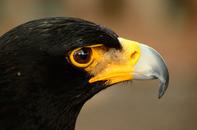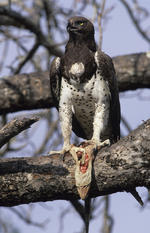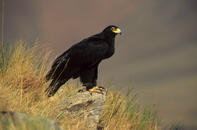Eagles and other birds of prey are often wrongfully accused of killing small livestock, because they will continue feeding on a dead animal, unlike caracal or jackal that will hide, when they hear people coming.

Eagles, however, are scavengers, so they often feed on dead animals. During the lambing season, they may even wait for an ewe to finish lambing to scavenge the afterbirth.
Verreaux (Aquila verreauxii) or black eagles are normally found along mountain ranges and rocky outcrops throughout Africa. These jet-black birds have yellow feet, a sharp hooked bill and a white V on their backs and rumps. Adult birds are 78 cm to 90 cm long, with a wingspan of 181 to 219 cm. They built their nests on cliff ledges or boulders, using the same nests for many years.
Martial eagles (Polemaetus bellicosus) are the largest eagle species in Africa, primarily found in open country and bushveld. Their nests consist of large stick structures built under the canopies of tall trees. The adult birds have brown upperparts and a short dark crest. The underparts are white with brown with black spots that extend to feathered legs.
The bill is strongly hooked and black, while the toes are bluish grey with large curved talons. Adult birds are 78 to 96 cm long with a wingspan ranging between 188 to 260 cm. Rock dassies (hyrax) comprise about 90% of a Verreaux eagle’s diet, while hares, rock dassies, leguaan and game birds comprise the main supply in the martial eagle’s diet.
Killing and Feeding Pattern

Martial and Verreaux eagles rarely pose a threat to small stock. When damages do occur, it’s usually caused by rogue individuals that are less experienced in hunting and are desperate for food. On these rare occassions, the targeted animal will be small, not weighing more than 5 kg.
Prey is usually, therefore, chicken or lambs and kids that are only a few days old. Cattle farmers have nothing to fear from eagles since a newborn calf is far too big for even the largest eagle to tackle. Eagles kill with their talons, by a strike to the head or more usually a crushing grip on the neck or upper back of the prey.
Irregularly spaced punctures to the skin or skull, surrounded by massive bruising under the skin, are therefore signs that an eagle might have been responsible for the killing. Remember that signs of feeding are not an indication that an animal had been killed by a bird of prey. When feeding, eagles will pluck out large quantities of fur or wool.
They usually feed from just behind the front limbs, working their way towards the head. They will eat the lungs, heart and other organs and sometimes pull the intestines through the cavity they have made. With their beaks, they will neatly peck out the meat from between the bones, leaving the carcass well cleaned. They never tear the stomach wall.
Management

Eagles and birds of prey are protected species, so may not be killed under any circumstances. If it can be proved that an eagle is responsible for killing stock, farmers should contact the nearest nature conservation authority or an expert to help move the rogue individual.
It makes sense to look after your residential pair of eagles, as both Martial and Verreaux eagles occupy large territories and their presence will help to keep rogue birds out of the area. Sound farming practices should be used to ensure eagles are not tempted to switch from their natural prey to small livestock.
Farmers can do this by having a minimum number of lambing seasons per year to allow for better and easier care of lambs. Lambing herds should not be situated near nests, but rather closer to the homestead or a place with a lot of of human activity. A shepherd may also help to protect young animals if they have to graze in remote areas. Ewes that abandon lambs should be culled. Chickens should be kept in enclosures.